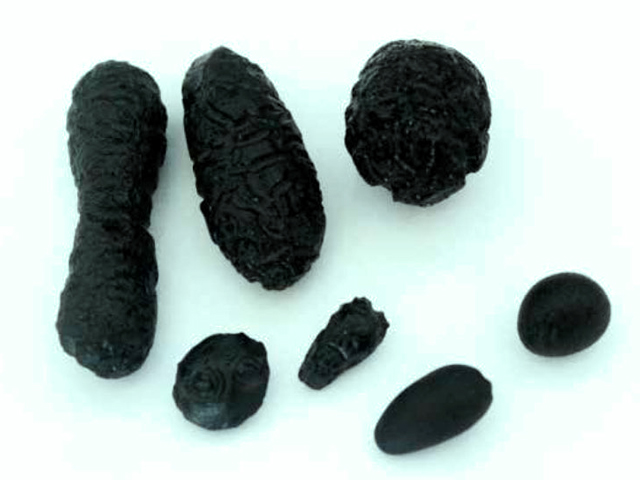There are eight main geologically significant features of Belitong Geopark, namely: (1) Belitong Tor Granite Landscape, (2) The Unique Satam Stone or Billitonite or Belitung Tektite; (3) Variations of Granite, Granitic and Quartz Diorite Rocks in the South End of the Malaya Tin-Belt; (4) The Uniqueness of the History of Old Tin Mining in Indonesia, (5) Outcrops of Permo-Carbon Sedimentary Rocks and the Uniqueness of Tin Genesis; (6) Sediment Outcrops where Typical Kerangas Ecosystems grow, (7) Landscapes and Content of Small Islands Around Belitung Island, and (8) Biogeography and Relation of Geological, Biological and Cultural Diversity. Four to five of these assets have international or national - international rankings, namely number(1), (2) and 3), (7) and (8).
Belitong Tor Granite Landscape
This small-scale topography or landscapes as a result of weathering and erosion in granite rocks tend to be rounded and stacked. “Tor” landscape is very typical, found or seen in granite outcrops of rock. The granite tor formation is characterised by the remained massive granite which has the low joints portions appearing on the surface. The granite bulges reflect the low rates of the denudation process which can associate to the very limited the water intrusion into the granite rock. The quick tor process can occur in the massive joints percentage into granite rock to disintegrate the weathered materials.
The Unique Satam Stone or Billitonite or Belitung Tektite
The tekstites from Belitung or “Batu Satam” (= Satam stone) in local language are very rare element which can necessary be recognised as the international geological significance heritage. Those have been discovered in Belitung Island which is a part of Australasian strewn field. These are distributed approximately 18 to 19 percent of the world (Mccall, 2005).
Variations of Granite, Granitic and Quartz Diorite Rocks in the South End of the Malaya Tin-Belt
Belitung Island is the southern tip of the tin belt (Malay belt) of the Malay Peninsula which gives rise to granite rocks aged Triassic, around 200 millions years ago (ma) to 250 ma. This granite rock is S-type granite according to Pitfield, 1987; Baharudin & Sidarto, 1995; or Tanjung Pandan Granite (Baharudin & Sidarto, 1995) which contain economical tin. In addition to tin, the granite and rocks affected by its appearance also produce rare earth elements (REE) and other important minerals.
History of the oldest Tin Mining in Indonesia
Tin mining that started in the 1700s and the society that revolves around tin industry is an important element of the history of Belitong.
Nam Salu Open Pit in the Gunung Kik Karak represents the unique history of the oldest tin mines in Indonesia and Southeast Asia where tin were mined from tuffaceous sedimentary which is rich in tin; while the remaining chimney of the stoven provides a glimpse of tin processing industry of the past.
Outcrops of Permo-Carbon Sedimentary Rocks and the Uniqueness of Tin Genesis
Permo-Carboniferous (Permo-Carbon) age sedimentary rocks in Belitung are found in the form of two formations, namely the Kelapa Kampit Formation and the Tajam Formation. The relationship between the two formations stratigraphically in the field is known to be so far which means that the two formations are deposited almost at the same time based on the fossils encountered.The existence of these two rock is very important, because in addition to being the oldest rock on Belitung Island, the mineral content and geological diversity plays a major role in shaping Belitung’s unique ecosystems above it.
Cendil Heath Forest
Sediment Outcrops where Typical Kerangas Ecosystems Grow
Sedimentary rock of Tajam formations mainly composed of quartz sandstones with siltstone intervals. This formation also contains primary tin seeds which are found with quartz in fracture veins and tissues. The important values of this formation, in addition to primary tin ore, also contain minerals / other elements, such as copper, as well as REE content.
This formation is the habitat or Kerangas Forest ecosystem that is typical of Belitung Island. Kerangas Forest in Cendil, Pepuyo Village and Ibul Village grow in weathered quartz.
Tanjung Kelayang
Landscapes of Small Islands Around Belitung Island
The 241 islands surrounding Belitung provide an extraordinary landscape and give birth to a unique island lifestyle and culture.
As Belitung waters was an important trading route since Srivijaya Kingdom to the colonial era, the waters around the islands is also home to historical shipwrecks with their riches, legends and history.
Tarsier Belitung (Chepalopachus bancanus saltator)
Biogeography and Relation of Geological, Biological and Cultural Diversity
Belitung Island is rich in biological diversity, one of which, Tarsier Belitung (Chepalopachus bancanus saltator), is an endemic fauna of Belitung. Diverse fish species and unique flora also make Belitung attractive for studies or biogeography or distribution of life in its natural state.
Belitung, rich in cultural diversity demonstrates the close link between geology, biology and culture, as can be seen in the Heath Forest ecosystem.










